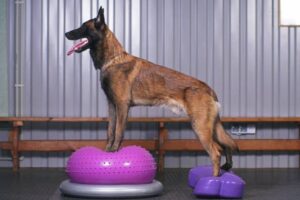As a pet owner, ensuring the health and well-being of your furry friend is a top priority. When your dog experiences physical ailments, whether due to injury, surgery, or chronic conditions like arthritis, finding the right professional care becomes crucial. Dog physical therapists have emerged as essential players in veterinary care, offering specialized treatments to manage pain, improve mobility, and enhance the overall quality of life for dogs. If you’ve ever searched for the “best dog physical therapist near me,” you know the importance of finding a qualified and experienced professional to support your pet’s needs. This article explores the role of dog physical therapists, the conditions they treat, and how to find the best care for your canine companion.
 Understanding the Role of a Dog Physical Therapist
Understanding the Role of a Dog Physical Therapist
A dog physical therapist is a trained professional who focuses on the rehabilitation and physical well-being of dogs. They employ a range of techniques to manage pain, enhance mobility, and improve overall physical function. These therapists work closely with veterinarians to create customized rehabilitation plans tailored to each dog’s specific needs.
Common Conditions Treated by Dog Physical Therapists
Dog physical therapists address a wide range of conditions, including:
- Arthritis: Common in older dogs, arthritis causes joint inflammation and pain. Physical therapy can help manage symptoms and improve joint function.
- Hip Dysplasia: A genetic condition that leads to improper hip joint development, causing pain and mobility issues. Therapists use exercises and other treatments to strengthen muscles and support the joint.
- Cruciate Ligament Injuries: Similar to ACL injuries in humans, these injuries cause knee instability. Rehabilitation can aid in recovery post-surgery or, in some cases, prevent the need for surgery.
- Neurological Disorders: Conditions such as intervertebral disc disease (IVDD) can lead to paralysis or weakness. Physical therapy helps in regaining strength and function.
- Post-Surgical Recovery: After surgeries like hip replacements or fracture repairs, physical therapy is essential to restore full function and speed up recovery.
Techniques Used by Dog Physical Therapists
A variety of techniques are employed by dog physical therapists to address different needs:
- Manual Therapy: This includes massage, joint mobilization, and stretching to reduce pain and improve range of motion.
- Therapeutic Exercises: Customized exercises strengthen muscles, enhance balance, and improve coordination. Examples include controlled walking, sit-to-stand exercises, and using balance boards.
- Hydrotherapy: Water-based exercises, such as swimming or underwater treadmill sessions, provide a low-impact way to strengthen muscles and improve cardiovascular health.
- Laser Therapy: Low-level laser therapy reduces inflammation and pain, promoting tissue healing.
- Electrotherapy: Techniques like transcutaneous electrical nerve stimulation (TENS) manage pain and stimulate muscle contractions.
Benefits of Physical Therapy for Dogs
The benefits of physical therapy for dogs are numerous:
- Pain Relief: Therapeutic techniques help manage chronic pain, providing relief and improving the dog’s comfort.
- Enhanced Mobility: Physical therapy restores and enhances movement, allowing dogs to engage more freely in daily activities.
- Accelerated Recovery: Post-surgical rehabilitation accelerates healing, reduces complications, and improves surgical outcomes.
- Improved Strength and Fitness: Targeted exercises build muscle strength, support joints, and promote overall fitness.
- Weight Management: For overweight dogs, physical therapy can be part of a weight management plan, reducing strain on joints and improving overall health.
Finding a Dog Physical Therapist Near Me
Choosing the right dog physical therapist is crucial for effective treatment. Here are some tips to help you find the best dog physical therapist near me:
- Certification and Training: Look for therapists who are certified and have undergone specialized training in canine rehabilitation. Organizations such as the American Association of Rehabilitation Veterinarians (AARV) and the Canine Rehabilitation Institute (CRI) offer certification programs.
- Experience: Select a therapist with experience in treating the specific condition your dog is facing. An experienced therapist is more likely to provide effective treatment and handle any complications that may arise.
- Reputation: Seek recommendations from your veterinarian or other pet owners, and read reviews to gauge the therapist’s reputation. A reputable therapist will have positive feedback from clients and colleagues.
- Facility and Equipment: Ensure the facility is well-equipped with the necessary tools and equipment for comprehensive rehabilitation. A well-equipped facility will offer a range of therapies tailored to your dog’s needs.
- Approach to Care: A good dog physical therapist will develop a personalized treatment plan tailored to your dog’s needs and will communicate effectively with you throughout the process. They should be willing to answer your questions and provide guidance on how to support your pet’s recovery at home.
The Search for the Best Dog Physical Therapist Near Me
Finding the best dog physical therapist near me involves thorough research and consideration of various factors. Start by consulting your veterinarian, who can provide referrals to trusted professionals. Online directories and reviews can also offer insights into the experiences of other pet owners.
Visiting potential therapy centers is a crucial step. Assess the cleanliness, equipment, and overall environment of the facility. Observe how the staff interacts with the animals and ensure they demonstrate a compassionate and professional approach.
Conclusion
Dog physical therapists play a vital role in the realm of veterinary care, offering specialized treatments that significantly improve the lives of dogs with various physical ailments. Through a combination of therapeutic exercises, manual therapy, hydrotherapy, laser therapy, and electrotherapy, these professionals help manage pain, restore mobility, and enhance overall well-being. As awareness of the benefits of physical therapy for dogs grows, more pet owners are turning to these specialists to ensure their furry friends lead healthier, more active lives. Whether addressing chronic conditions or aiding in post-surgical recovery, dog physical therapists are essential partners in promoting optimal health and quality of life for our canine companions.